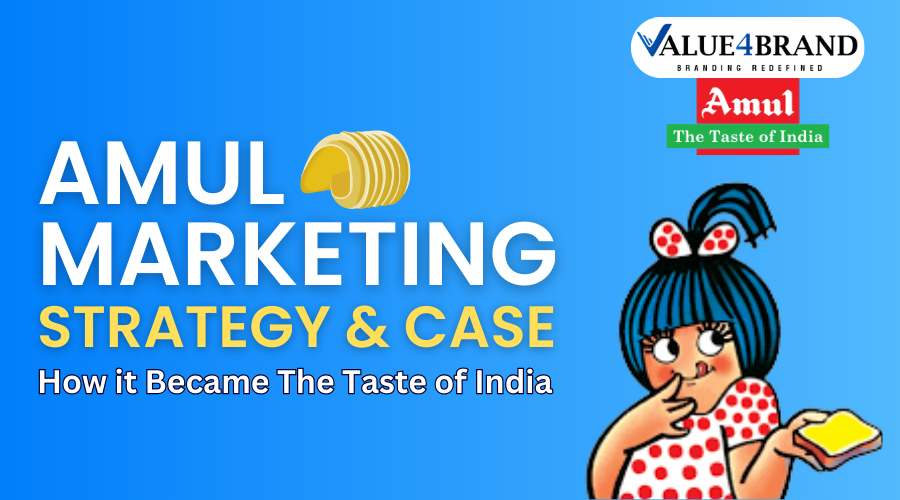Amul is one of the most beloved and well-recognized brands in India, offering a wide range of quality dairy products to millions of people. Amul is the perfect example of a brand that has captured the hearts and minds of Indian consumers through its innovative and effective marketing strategies. The Amul milk cooperative business, established in 1946 in Gujarat, India, soon became an iconic name in Indian households.
Today, even after 75 years, it is still one of the most popular brands. Its unique marketing strategy continues to engage and amuse Indian consumers. Thus, it is worth studying the Amul marketing case study, strategy, and how it become an inspiration for many other brands.
The Beginning of Amul Brand
Anand Milk Union Limited, abbreviated as Amul, is an Indian dairy cooperative society established by Dr. Verghese Kurien. Amul, soon after its launch, became one of the largest food brands in the country, offering a wide range of dairy products, including milk, butter, cheese, ice cream, and more.
The most amazing thing about Amul is that it is neither a privately owned nor a public company. It is a cooperative society that started to provide justice to farmers, established with the mission to ensure fair prices and provide better opportunities to farmers.
Amul Target Customer
Amul’s target audience is divided into two main segments including business-to-consumers (B2C) and business-to-business (B2B).
1. Business to Consumers (B2C)
Amul has meticulously crafted its product portfolio catering to diversified consumers of different age groups. Since the brand’s audience spans different age groups and lifestyle segments, it designs strategically accordingly addressing the unique requirements of each cohort.
For kids, it has various products including Amul milk, chocolate, Amul Kool, and Nutramul. For youth, the range of Amul products includes Amul Pizza, Amul cheese spread, and Amul Pizza Cheese. It targets health-conscious customers through a separate range of products including Amul lite butter, Nutramul, Amul Shakti, and Sugar/skimmed milk powder.
Amul holds the Guinness World Record for the longest-running advertising campaign, which further strengthens its position as a beloved brand engaging consumers across age groups.
2. Business to Business (B2B)
Though Amul’s products mainly target its B2C market, the brand significantly emphasises its B2B segment. This strategic focus on the B2B market is due to the bulk purchase of its products from various companies. These companies are regular, reliable sources of revenue for Amul. Amul regularly delivers milk to restaurants, Ice cream manufacturers, Tea & coffee cafes, and local food stalls. While butter, ghee, Cheese, Paneer, etc. are demanded the most by restaurants, bakeries, food stalls, etc.
Amul’s Advertising Strategy
The Amul Girl
Amul strategy featured the legendary “Amul Girl” which has gained wider popularity since the launch. This charming and clever mascot represents Amul’s brand and establishes an emotional connection with the customers. Amul strategy also includes having a dynamic presence on social media platforms through Facebook ads, X(formerly known as Twitter), and Instagram content strategy centric on Amul Girl.
The Amul Girl made her debut in the advertising world with an unforgettable campaign that introduced Amul Butter as ‘Utterly Butterly Delicious.’ This slogan a part of Amul Marketing Strategy became an instant sensation and a resounding success.
Building a Brand
Another important Amul advertising strategy is that the company always laid a strong focus on quality and innovation, which helped it stay competitive despite decades of establishment. The company always looked for ways to improve and introduce new products. The main reason behind this is the brand’s iconic advertising, consistent messaging, ability to be relatable, cultural relevance, timelessness, digital presence, and strategic brand extensions. It’s because of all these marketing strategies, which made Amul a part of Indian culture and food.
Major Focus on Low-Cost Products without Compromising on Quality
Amul has always managed to maintain its position as a market leader by offering high-value products at the most affordable rates. The marketing strategy adopted by Amul helped in catering to a huge base of Indian consumers and building trust and loyalty among its customer base. The low-cost, high-value approach has been a critical driver of Amul’s success, making it one of the most appropriate choices for millions of Indian households.
Smart and Engaging Taglines
As part of Amul’s online marketing strategy, it always focuses on simple, engaging, and remember taglines, often reflecting the brand’s values and personality. For instance, taglines line “Utterly Butterly Delicious”, “The Taste of India, etc. have become quite popular among consumers over the years.
These catchy and engaging slogans not only just deliver the message but also evoke positive emotions and associations with Amul’s brand identity.
All Products are Sold Under One Umbrella
Amul marketing strategy consists of selling all its products under a single, unified brand umbrella. Since, consumers recognize and trust the Amul brand for quality and consistency across all product categories: milk, butter, cheese, ice cream, or chocolates, it uses the same for launching new products.
Also, Amul managed the whole supply chain of milk production efficiently; beginning from the pooling of milk from various small dairy farmers to supplying it to the end consumer, the entire process was seamless.
The unified branding approach not only strengthens brand equity but also eases its marketing efforts.
Amul’s Digital Marketing Strategy
In an emerging marketing scenario where digital channels have become immensely popular, Amul has adapted its advertising strategy to embrace the digital space. Although its presence in television advertisements has remained least effective due to digital marketing, still it is moving ahead with the technology by using various Amul marketing strategies. Amul’s digital marketing initiatives have played an important role in increasing its reach and boosting engagement among its targeted audience across various platforms.
Amul has leveraged the power of various digital marketing channels including social media, email marketing and influencer collaborations to promote its products and connect with its audience in the digital sphere.
1. Social Media Presence
Amul recognizes the significance of a strong social media presence and has firmly established itself on platforms such as Facebook, Twitter and Instagram. The company through these platforms share engaging and informative content that not only showcases its wide range of products but also reinforces its brand values.
One example of Amul online marketing strategy is the way it leveraged a popular Indian festival, Chhath Puja, to promote a new product. Post running initial ads to build awareness about the new offering, Amul lately adapted its messaging to align with the upcoming Chhath Puja celebrations. The brand created eye-catching Facebook ads that seamlessly integrated its product with the festive theme, enhancing the cultural significance among the people.
2. Email Marketing
Amul has adopted email marketing as a powerful tool to connect with its targeted customers. The brand regularly sends newsletters and promotional emails to its customers, in an attempt to keep them updated with new products, special offers and product launches. Through this channel, Amul ensures that its customers are well-informed about its offerings and remain engaged with the brand.
3. Influencer Marketing
Recognizing the power of influencer marketing, Amul collaborates with influencers and bloggers to promote its products. This strategic collaboration enables Amul to tap into its existing audience of influencers, thereby expanding its reach to new and potentially untapped consumer segments.
Popular Marketing Campaigns of Amul Dairy Products: Amul Marketing Case Study
Amul’s marketing efforts are not restricted to its iconic Amul girl advertisements and Amul online marketing strategy initiatives. The brand has so far launched many successful marketing campaigns which further strengthened its position in the market.
1) #CelebratingDrKurien
The #CelebratingDrKurien campaign was a marketing initiative launched by Amul in 2018 to honor the 98th birth anniversary of Dr Verghese Kurien, Amul’s founder.
2) #amulrecipes
The #amulrecipes campaign was a marketing initiative launched by Amul on YouTube. During this campaign, Amul created more than 300 videos showcasing recipes featuring Amul products, demonstrating the brand’s versatility and utility.
3) Amul Classics
Launched in 2020 during the COVID-19 pandemic, through the Amul Classics campaign, the brand revived its classic ads from the 1990s to air during the re-runs of Ramayan and Mahabharat on Doordarshan, which were very popular at the time of the pandemic. Also, it uploaded a series of 88 classic ads from the 90s to its YouTube channel, creating a playlist titled “Amul Classics”.
Conclusion
Indeed, Amul’s digital marketing strategy represents a visionary approach that has allowed the company to remain competitive in this ever-changing business world driven by digital interactions. By leveraging various digital marketing channels, Amul has increased its reach, established long-term connections with its audience, and effectively promoted its diverse product portfolio in the digital world.
With Amul continuing to grow and evolve, it will be quite interesting to see how the brand adapts its marketing strategy to stay relevant and competitive in the increasingly crowded and dynamic market. The best way of doing this is to connect with a Digital Marketing Agency in Delhi that uses innovative marketing strategies and a customer-centric approach to help businesses achieve similar levels of success.















